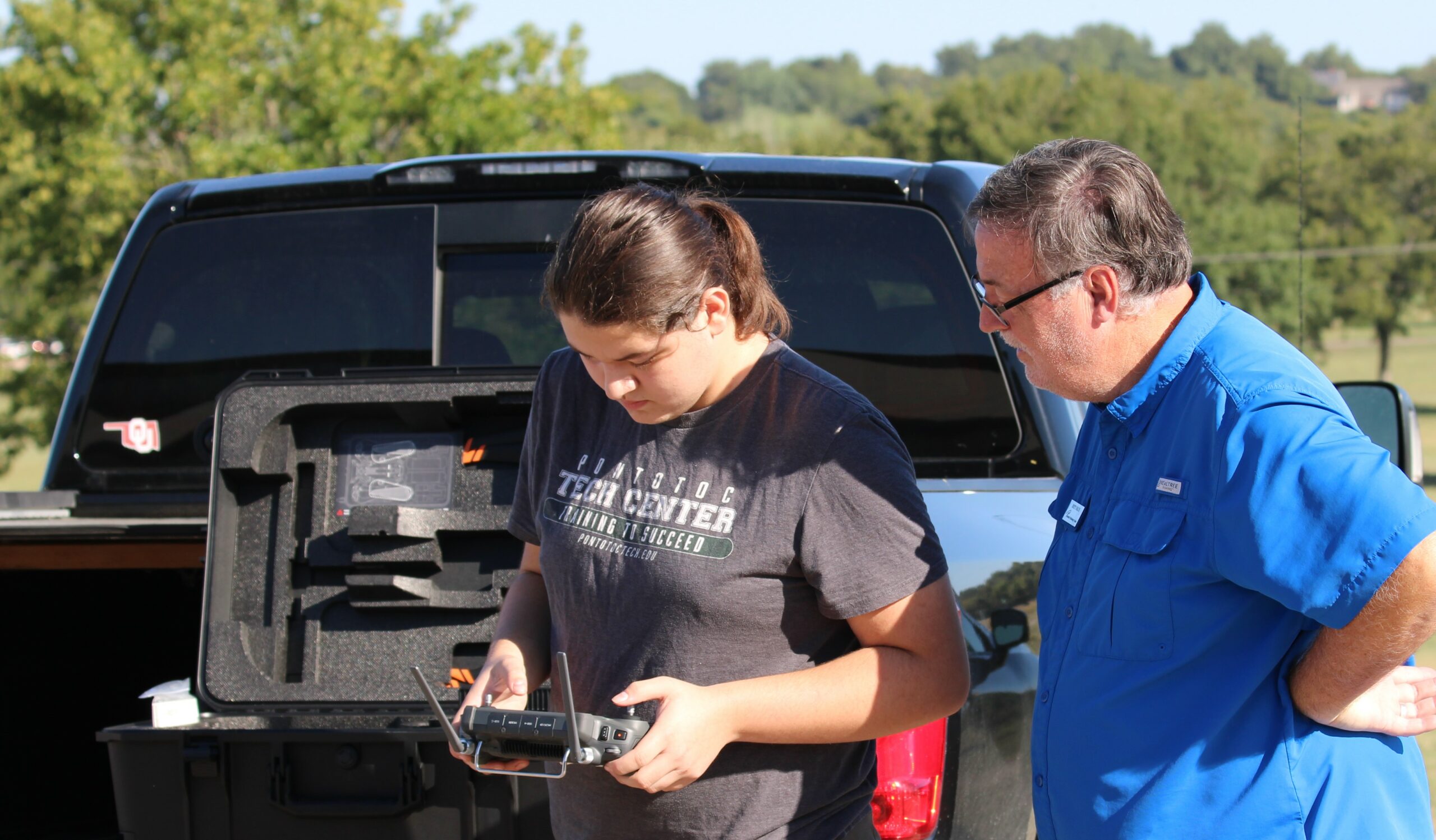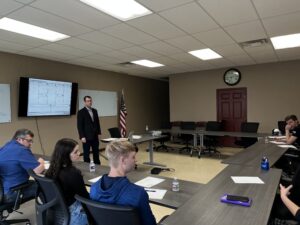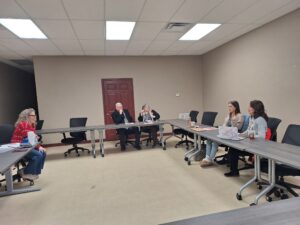
Unlocking the Sky: How Pontotoc Technology Center Is Training the Next Generation of Drone Experts
September 29, 2023 by Jessika Leatherbury
By: Sunnie Dawn Baker
 When drones first came on the market, many saw them as a toy, much like the remote-control airplanes and helicopters of our youth. However, while drones can be used for fun and recreation, the possibilities for applications of the technology, as well as the educational components involved, are nearly endless. As this technology evolves, more becomes possible. And as people learn how to use the new advances, they also find new ways to utilize this technology in novel ways. This is one of the reasons why, in 2016, Jim Lawson and Brent Balch started a drone program at Pontotoc Technology Center (PTC).
When drones first came on the market, many saw them as a toy, much like the remote-control airplanes and helicopters of our youth. However, while drones can be used for fun and recreation, the possibilities for applications of the technology, as well as the educational components involved, are nearly endless. As this technology evolves, more becomes possible. And as people learn how to use the new advances, they also find new ways to utilize this technology in novel ways. This is one of the reasons why, in 2016, Jim Lawson and Brent Balch started a drone program at Pontotoc Technology Center (PTC).
In the beginning, David Lassiter, then superintendent at PTC, came to Lawson with the idea of establishing a drone program. Lawson had a background in aviation as an aircraft pilot and knew that Balch already flew drones. Balch enthusiastically agreed to join the new program. Lawson and Balch purchased three drones for PTC and went to a different tech center to learn how to fly them. Only two other tech centers in Oklahoma had drone programs at the time and they adapted the other’s drone program curriculum, modifying it to suit their own purposes.
Their first class at PTC had six people and met two nights a week. They started out offering Basic Drone Flying and Advanced Drone Flying, though they have now branched out to offer a 107 Commercial Certification Preparation Course which prepares drone pilots to take their commercial certification test through the FAA. Through the programs at PTC, a student can begin without any prior knowledge of drones and work to eventually become a licensed drone pilot and use those skills commercially.
The Basic course introduces students to drones. The instructors talk about what the drones are, how they work, what they do, and how to be safe and responsible with the technology. There are a lot of rules to follow when it comes to drones and this course focuses heavily on instilling these in the students. After the students learn these basics, then they can move on to the Advanced course that deals with more of the automatic features. During this course, the students learn how to program the drones to automatically complete flights and are essentially hands free at that point.
Balch says, “When we started this it was still in the novelty phase and now it has transformed from novelty to necessity.” While drones can be fun, they also serve an especially important purposes in many industries. When many people think about the commercial uses for drones, they tend to think about video and photography—those great aerial shots of cities or real estate. However, the application goes far beyond pretty pictures. One of the most important things that can be done with drones is search and rescue. Drones can not only see what we can, they can also recognize heat signatures. So, if a search was needed, drones could be an active part of the process, having eyes in the air that can sense much more detail than the human eye. PTC has trained members of the local police departments, fire departments, and the Sherrif’s office in this technology. They have even done a mock search and rescue to give these first responders practical experience using the technology.
Beyond public safety, though, there are also many more commercial applications and industry uses. Drone technology is important for oil and gas operations and drones can also help electric companies perform line inspections. This is one reason why Lawson wants to incorporate drone technology into the Lineworker Academy at PTC. Construction companies can use the technology to make a video to document the progress of construction. Mining companies can save untold hours and dollars using drones to measure exactly how much material has been removed from the ground and where it is now. For the mining application specifically, a drone-less attempt to perform this task would take days. Now, these companies can use drones to reduce this effort to a 40-60 minute flyover, allowing the company to receive a report within 24 hours. Similarly, drones can also be used in agriculture, whether monitoring herds of animals or the health of crops. As the technology develops, the applications multiply.
Because of all the possibilities in drone technology, Lawson and Balch want to inspire young people to learn these skills as well. One way that they are doing that is through the Drone Racing League. They received a grant through Oklahoma CareerTech to educate students and help as many industries as they can with this technology. Part of the grant money went toward the Drone Racing League and purchasing four drone kits that the students will assemble, learn how to program, and then fly competitively against other teams across the nation. Because of the nature of the technology, they can race at PTC and their scores can be uploaded, without a need for travel. This season, sixteen local high school juniors and seniors will be able to have this experience and have fun, while also broadening their knowledge of drone technology.
With all the possibilities of drone technology, the possibilities for innovation and entrepreneurship are endless. Lawson says, “We are still learning. We are learning every day.” The technology is moving so quickly that there is no rest; they must constantly be moving forward in their knowledge and expertise in order to teach their students. Balch notes, “Two days before we were about to order an aircraft, it upgraded. It is constantly evolving.” With this constant forward movement in drone technology, opportunities for new applications are there for those who educate themselves in this field. To find the course schedule to learn about drones, visit https://www.careertechweb.org/ptc/.
Sign up to receive more news from the Ada Jobs Foundation HERE!
Written by
Jessika Leatherbury
You may also interested in:

Adapt and Overcome: Allison Poe’s Recipe for Resilience and Growth
By: Sunnie Dawn Baker Allison Poe has always followed her feet. She waits for the signs to appear and, once she recognizes them, she travels that path, and has never
Jeff Warren: A Life in Sound, Vision, and Storytelling
By: Sunnie Dawn Baker When Jeff Warren got involved in the Houston music scene as a teenager, he had no clue where his path would lead. Now, nearly thirty years
From Pitch to Progress: ECU's Glass Recycling Program Turns Waste into Opportunity
By: Sunnie Dawn Baker In 2018, Dr. Christine Pappas competed in Ada Jobs Foundation’s Big Pitch Competition by promoting grinding glass bottles into sand. She won the Big Pitch that
The Importance of Customer Discovery: Know Your Audience and Know Your Market
By: Sunnie Dawn Baker Entrepreneurs and small business owners must consider many factors to achieve success, with their target market being one of the most crucial. Sometimes, when people are
What Does Economic Development Do for You? The Significance of the Economic Multiplier
By: Sunnie Dawn Baker People often find the term “economic development” vague and confusing. Understanding how economic development works and benefits the community can be challenging. Though there are many
Helping Entrepreneurs One Workshop at a Time: Lauri Rowe and QuickBooks for Small Businesses
Entrepreneurs tend to be filled with passion and big ideas. They have found a solution to a problem they see in the world, and they barrel ahead, excited for their
Hunter Cook: Technology, Entrepreneurship, and the Written Word
By: Sunnie Dawn Baker Hunter Cook started writing when he was seven years old. At first, he wanted to write comic books, but then he realized he couldn’t draw. He
Empowering Native Artists: FAME App Brings Innovation to First American E-Commerce
By: Sunnie Dawn Baker Entrepreneurs are problem solvers. They are constantly striving for solutions to issues they see in the world or in their own lives. In the case of
Learn, Connect, and Grow: 2025 Workshops for Aspiring and Current Business Owners
By: Sunnie Dawn Baker A new year brings new possibilities, and, at the Ada Jobs Foundation, it also brings a new round of programming and workshops. As the local Economic